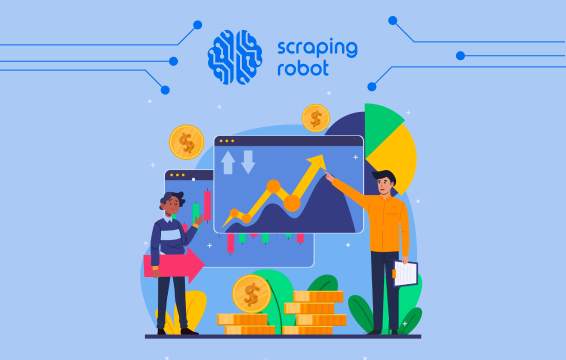4 Ways You Can Increase ROI Using Web Scraped Data

Numbers on paper aside, to really make money in business, you either have to make more than you spend or spend less than you make. (I prefer to make more). Also, you have to make sure that every dollar you spend is bringing in returns. And there lies the crux of the matter. How do you keep an eye on every dollar to make sure it isn’t slacking? How do you identify new opportunities to put your dollars to work? In short, how do you increase ROI from your marketing and business efforts? ROI stands for Return on Investment. It is a measure of the loss or gain made from each unit of an investment relative to its cost.
As of 2018, only 17% of marketers claim to be able to measure ROI on all their marketing activities, according to a report published by Katar-Millward Brown. While this figure might have increased over the past two years, it is still indicative of the fact that many marketers find it challenging to measure ROI on their activities. And if you can’t measure ROI, you can’t increase ROI. The difficulty in measurement usually results from a lack of proper data collection techniques or tools. This is why, in this article, we’ll be taking a look at web scraping as a data collection solution for collecting ROI data.
We’ll also explore why you need to maximize ROI and different ways to use data to increase ROI and profitability of your marketing efforts. If you already have a solid understanding of what ROI is and why you need to maximize it, feel free to use the table of contents below to skip to the more interesting sections on using web scraped data to boost ROI.
Table of Contents
Why Do You Need To Maximize ROI?

Unless you are running a charity, It’s safe to assume you are in business to make money. Now, generally, this means making more than you spend. More specifically, though, it means making sure every dollar you spend is earning more than a dollar in return, directly or indirectly. This is the basis of ROI maximization. However, many business owners only take a look at how they can boost return on investment at the point where they believe money is actually being made: sales. While increasing sales ROI is important, it is a mistake to neglect other departments, such as marketing. To increase marketing ROI means to get more of your audience responding to your marketing efforts, which leads to more customers and, ultimately, more money for you. You can increase marketing ROI by tracking your ad spend and identifying the sections of your audience with the best response to your marketing efforts. If for every ten dollars you spend on ads, you get 15 people clicking on your ads, and 5 of them go on to become customers, buying three dollars worth of product each, then you have made fifteen dollars, which is a 50% return on your ten-dollar investment.
To maximize return on investment generally means you are increasing your business’s profitability not just in one section but in all the departments.
How To Increase ROI
Like we were taught in elementary school, to make a profit, your cost price must be lower than your selling price. Or your income must be more than expenditure. The same principle applies here. To increase ROI, you have to make more money. And if possible, spend less. But how exactly do you do this? Let’s take a look at a few specific methods to increase ROI on your business efforts.
- Sell more: I’ve said it over and again, but I’ll keep saying it still. The easiest way to increase ROI is to make more money. And the easiest way to make more money is to sell more.
- Raise your prices: If you are unable to increase your sales significantly, another method is to raise your prices. This makes your selling price higher than the cost price, and according to elementary economics, that equals a profit. However, be careful with this, so you do not price yourself out of the market.
- Measure everything: “What gets measured, gets done.” Setting proper measurement metrics makes it easy to identify the underperforming aspects, so you can shift focus from them to the high-performing ones and squeeze more returns out of your marketing or sales spend.
- Experiment: If you keep doing the same things you’ve been doing, you’ll keep making the same amount of money. You can’t significantly increase ROI without trying out new things. Experimenting will allow you to determine the most effective ways to spend your money so you can make more.
However, one commonality between all these methods of increasing ROI is that they all require data. Large amounts of data. Now, most of this data is readily available. But how do you collect it? How do you efficiently collect the data in large volumes? How do you keep up with real-time analytics to identify opportunities to increase ROI? Let’s talk about web scraping.
How To Collect ROI Data

All the data you need to track performance successfully and identify ways to boost return on investment can be easily collected with web scraping. So what is web scraping? Web scraping works by using bots known as “crawlers” or “spiders” to parse through the HTML code of a given web page and tag datasets according to some preset parameters. Then data extractor bots extract the data into a spreadsheet.
With web scraping, you can easily collect data on your marketing and sales efforts in bulk. Once you have this data, you can input it into your analytics software to identify which campaigns are performing best. Web scraping bots also allow you to collect data in real-time by using API technology. This will enable you to keep up with real-time analytics and keep an eye on changing datasets.
Using Data To Increase ROI

With the evolution of the internet and the entire buying and selling ecosystem, buyers have also evolved. A new type of buyer has emerged: the informed buyer. Nowadays, the typical customer goes online to check out reviews from blogs, social media, forums, etc., before making a purchase. Now, most of the data your customers are basing their purchasing decisions on is also available to you. Even better, some data that your customers don’t even know they are making decisions on is also available to you. But how do you translate this data into an increase in ROI? Here are few ways:
- Competitor analysis: By collecting data on and analyzing the tactics of your competitors, you can identify which strategies work best for them and which ones do not. Since you share the same target audience, whatever method works for them is likely to work for you. This saves you the cost of experimentation and allows you to go straight to the implementation of the proven method. Also, you get to find out the mistakes they have made and avoid them. This way you are spending your money in ways already proven to be effective which helps you maximize ROI.
- Automation: Quality data is needed for quality automation. Like we mentioned earlier, when you use web scraping to collect data, you can feed that data directly into your analytics software which helps you track KPIs and identify high-performing tactics so you can use them more. Ultimately, this helps you minimize costs and make more money.
- Quality control: When you gather reviews from social media and other online platforms, you get to see what consumers are complaining about the most. This makes it easy for you to avoid the same problem and endear yourself to the consumers. Also, collecting data on your competitors show you the minimum and maximum quality level their products reach, and then you can do a cost-analysis to determine how high-quality you want your product to be. Either to beat them or to join them.
- Competitive pricing: Pricing is a very important aspect of sales. One way you can use to increase ROI is to raise your prices. However, you have to be careful to avoid overpricing which makes you lose customers, or underpricing which makes you lose money. The best way to do this is to collect data on industry-standard prices, competitor prices, and what consumers are willing to pay for the product. All of this data can be factored into developing a competitive pricing strategy that makes sure you get the most out of every single sale.
Scraping Robot as a Tool To Boost ROI

When it comes to implementing a web scraping strategy to collect data for ROI maximization purposes, the most straightforward method is to use a web scraping service like Scraping Robot. At Scraping Robot, we offer you all the scraping infrastructure you need, already done for you. All you need to do is sign up, and you can begin using it. Even better, unlike other web scraping services that offer a multipurpose scraper, we can collaborate with you to help you design your own custom-built data scraper tailored to fit your exact data needs and collect all the ROI data you need. To get started, all you need to do is send us a message detailing what you want, and our developers will get right on it.
Our Scraping service uses APIs and multiple proxies to allow you to scrape data from multiple web pages in real-time. This means that every time you want to check the reviews of a competitor or track consumer response to a campaign, all you need to do is put a request through to your custom scraper, and you’ll get the data you need instantly.
Conclusion

To effectively implement a strategy to increase ROI and make your business more profitable, you have to go down into the specifics and identify opportunities at the micro-level. And to successfully do that, you need data. Lots of data. At Scraping Robot, we like data, especially when there is a lot of it. Even better, we love seeing our customers bask in data bliss after successfully extracting data with our web scraping service. So send us a message and let’s help you get the data you need to make more money.
The information contained within this article, including information posted by official staff, guest-submitted material, message board postings, or other third-party material is presented solely for the purposes of education and furtherance of the knowledge of the reader. All trademarks used in this publication are hereby acknowledged as the property of their respective owners.
